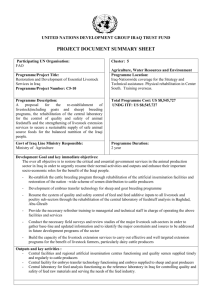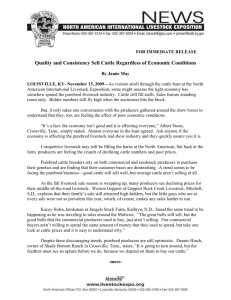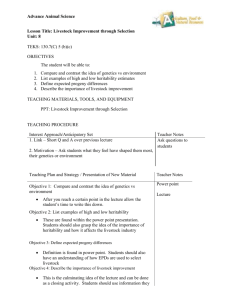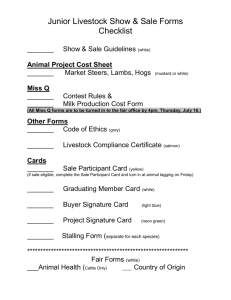Livestock producers have a major stake in the direction of
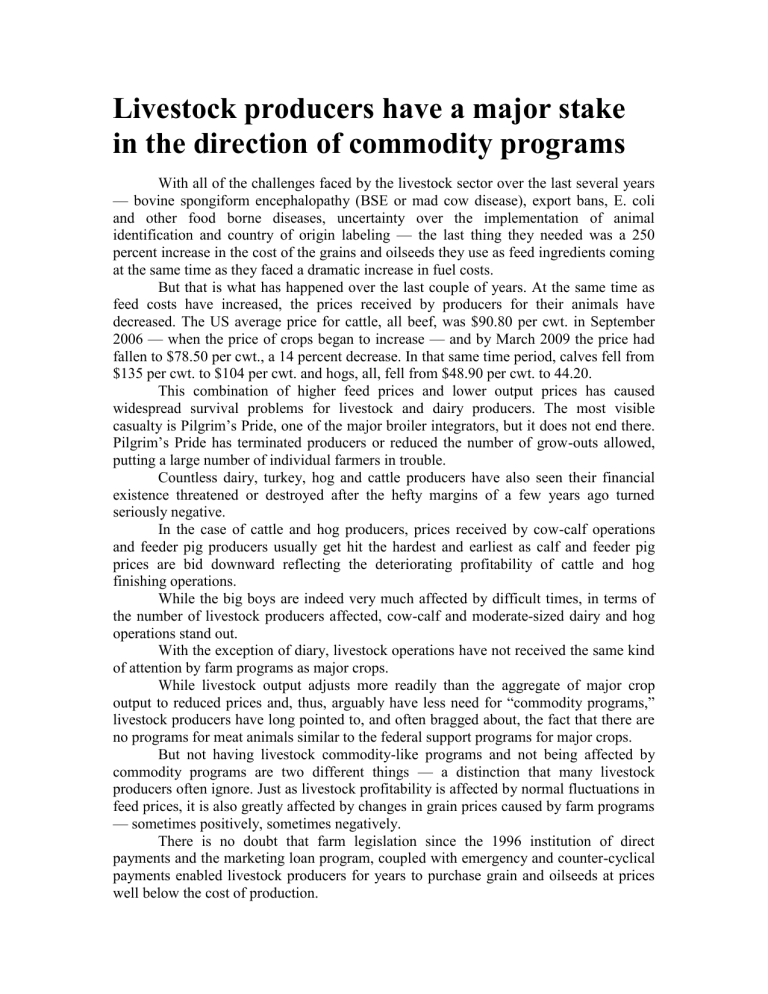
Livestock producers have a major stake in the direction of commodity programs
With all of the challenges faced by the livestock sector over the last several years
— bovine spongiform encephalopathy (BSE or mad cow disease), export bans, E. coli and other food borne diseases, uncertainty over the implementation of animal identification and country of origin labeling — the last thing they needed was a 250 percent increase in the cost of the grains and oilseeds they use as feed ingredients coming at the same time as they faced a dramatic increase in fuel costs.
But that is what has happened over the last couple of years. At the same time as feed costs have increased, the prices received by producers for their animals have decreased. The US average price for cattle, all beef, was $90.80 per cwt. in September
2006 — when the price of crops began to increase — and by March 2009 the price had fallen to $78.50 per cwt., a 14 percent decrease. In that same time period, calves fell from
$135 per cwt. to $104 per cwt. and hogs, all, fell from $48.90 per cwt. to 44.20.
This combination of higher feed prices and lower output prices has caused widespread survival problems for livestock and dairy producers. The most visible casualty is Pilgrim’s Pride, one of the major broiler integrators, but it does not end there.
Pilgrim’s Pride has terminated producers or reduced the number of grow-outs allowed, putting a large number of individual farmers in trouble.
Countless dairy, turkey, hog and cattle producers have also seen their financial existence threatened or destroyed after the hefty margins of a few years ago turned seriously negative.
In the case of cattle and hog producers, prices received by cow-calf operations and feeder pig producers usually get hit the hardest and earliest as calf and feeder pig prices are bid downward reflecting the deteriorating profitability of cattle and hog finishing operations.
While the big boys are indeed very much affected by difficult times, in terms of the number of livestock producers affected, cow-calf and moderate-sized dairy and hog operations stand out.
With the exception of diary, livestock operations have not received the same kind of attention by farm programs as major crops.
While livestock output adjusts more readily than the aggregate of major crop output to reduced prices and, thus, arguably have less need for “commodity programs,” livestock producers have long pointed to, and often bragged about, the fact that there are no programs for meat animals similar to the federal support programs for major crops.
But not having livestock commodity-like programs and not being affected by commodity programs are two different things — a distinction that many livestock producers often ignore. Just as livestock profitability is affected by normal fluctuations in feed prices, it is also greatly affected by changes in grain prices caused by farm programs
— sometimes positively, sometimes negatively.
There is no doubt that farm legislation since the 1996 institution of direct payments and the marketing loan program, coupled with emergency and counter-cyclical payments enabled livestock producers for years to purchase grain and oilseeds at prices well below the cost of production.
But that same legislation left livestock producers more vulnerable to severe price spikes than prior years because grain reserve programs and their price-moderating effects were eliminated in the 1996 legislation.
If the US had maintained adequate reserve stocks of corn and soybeans with sensible price bands, livestock producers would have been better able to factor in feed cost changes into their budgets. And, while they certainly would have seen higher feed costs in the face of increased demand for corn to make ethanol, the presence of reserves would have protected livestock producers from a tripling of costs.
The markets certainly would not have been as reactive to the spring floods of
2008 in the presence of a storage program that could have provided corn and soybeans in the case of a reduced crop.
These past two years have dramatically illustrated the risks livestock producers run in the absence of a crop reserve program. As a result it seems to us that livestock producers would want to support a sensibly designed and consistently administered stock reserve program would provide then with a stable range of feed costs.
With a reserve program, at the same time that livestock producers would be protected from wildly gyrating feed costs, crop producers could earn more of their income from the market during times when stock is added to the reserve instead of being dependent upon massive government subsidies.
The price experiences of the last two years following the tens of billions of dollars spent to prop up crop incomes in many of years since 1996 makes this an ideal time to reevaluate the operation and purpose of farm programs. In this series of articles we have focused discussion on government sponsored crop reserve programs and their potential impact on international trade, grain producers and livestock producers. In future articles we discuss impacts of reinstituting a reserve on consumers, taxpayers, the ethanol industry, and agribusinesses.
Daryll E. Ray holds the Blasingame Chair of Excellence in Agricultural Policy, Institute of Agriculture, University of Tennessee, and is the Director of UT’s Agricultural Policy
Analysis Center (APAC). (865) 974-7407; Fax: (865) 974-7298; dray@utk.edu
; http://www.agpolicy.org
. Daryll Ray’s column is written with the research and assistance of Harwood D. Schaffer, Research Associate with APAC.
Reproduction Permission Granted with:
1) Full attribution to Daryll E. Ray and the Agricultural Policy Analysis Center,
University of Tennessee, Knoxville, TN;
2) An email sent to hdschaffer@utk.edu
indicating how often you intend on running Dr.
Ray’s column and your total circulation. Also, please send one copy of the first issue with
Dr. Ray’s column in it to Harwood Schaffer, Agricultural Policy Analysis Center, 309
Morgan Hall, Knoxville, TN 37996-4519.
